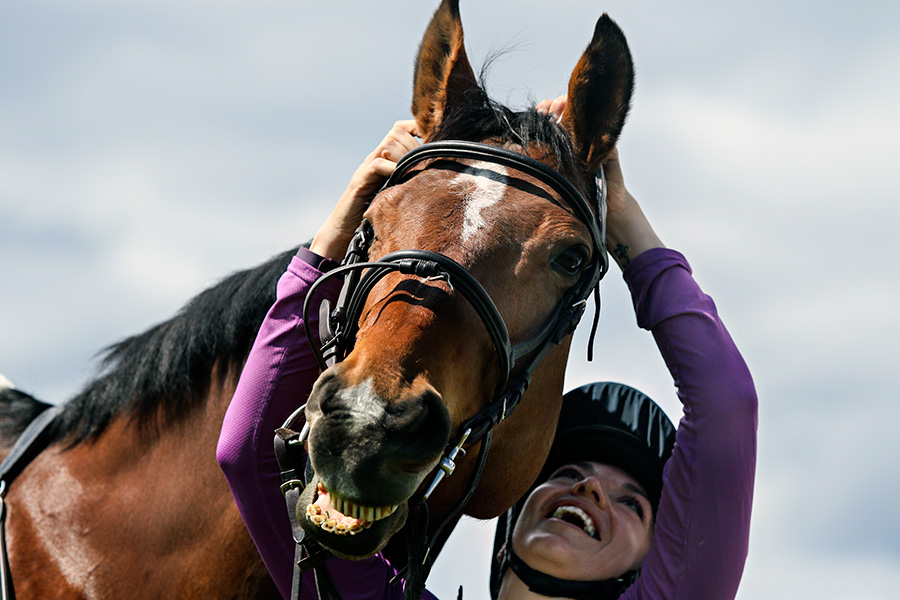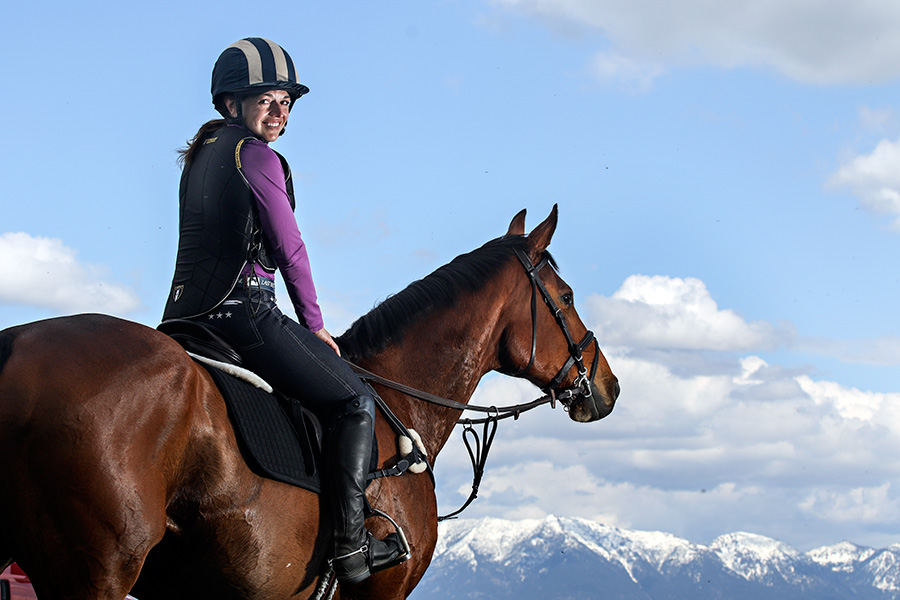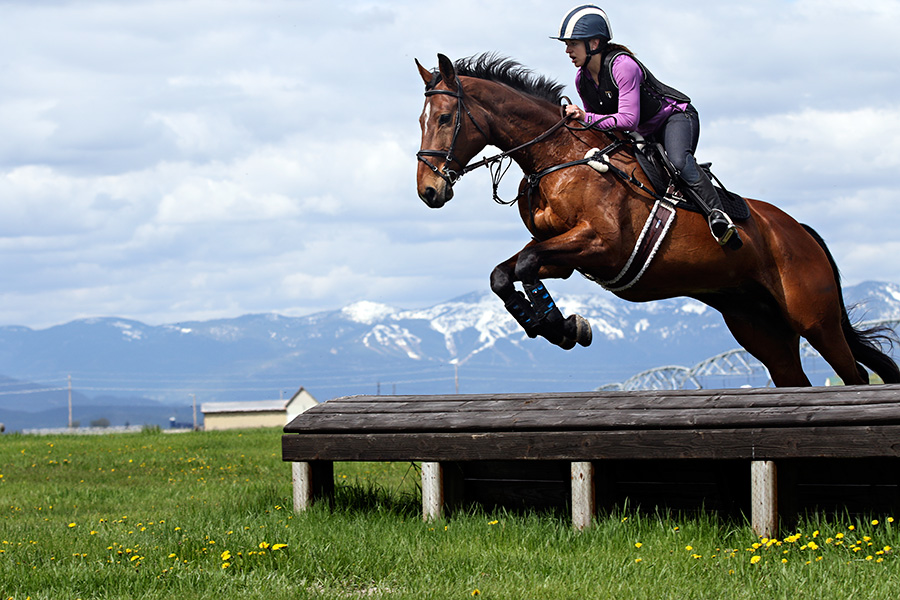Life After Racing
Thoroughbreds burn bright and fast as racehorses, but many go on to have longer, successful careers in other sports. The Event at Rebecca Farm in Kalispell offers a glimpse of these impressive athletes thriving in their second jobs.
By Molly Priddy
REBECCA FARM – To meet Zee the thoroughbred is to know power.
Standing in the sunlight of early summer’s first warm week, his flanks shivered and his veins popped, tiny rivers on a continent of muscle stretching from mane to tail.
It’s easy to imagine his legs pumping through the soft dirt of a racetrack, to see his muscles contract and expand as they once did when he was performing the single task he had been born and bred to do: run.
But his life is different now; there’s more to it. It’s not just to run, but also to jump and use precision and cooperate with the human on his back as they work as a team in the sport of eventing.
On this recent May day, he was sweating, his shoulder at eye-height for a 6-foot-tall person, and ripples of damp hair clung to his massive frame. He’d just been on a walkabout with his owner, Suzy Buckmaster, and their trainer, Jen Johnson, working on his jumping footwork in the months leading up to one of the largest equestrian triathlons in North America — The Event at Rebecca Farm, scheduled this year on July 19-23.
Zee snorted, a sound that, were you the romantic type, could make you think of kings and majesty and tough Western types.
But really, the issue was more mortal than those notions.
“He’s really upset about the bugs,” Buckmaster, of Kalispell, said.
It’s in that moment that Zee fully comes into focus: He’s a brawny creature capable of helping build the foundations of society as his ancestors did, but also a 12-year-old soul trying to exist in a mighty body.
It can be difficult remembering that Zee and others like him are complexly faceted beings, that they have fears and hang-ups, that they have barriers to overcome. But if they’re lucky, they get paired up with someone like Buckmaster, who is willing to use her strengths to help him with his weaknesses, and vice versa.
“He’s a lot braver than I am,” Buckmaster said as she brushed dried grass from Zee’s hide. “You become a team.”

For many racehorses, the sporting life begins early. According to a 2011 article in the Journal of Equine Science, racehorses typically peak at age 4-and-a-half. They improve the most between the ages of 2 and 4, and typically compete with their age cohort until their third year. From there, ages can vary, with some horses racing until they’re “well over 10 years old,” the study reported.
But for many of these equine athletes, the racetrack is the focus of their lives for only the first three or four years. Thoroughbreds have a life expectancy of up to 30 years, so these animals are pushed into and then out of high-power environments while they are still basically toddlers.
There’s no guaranteed retirement program for racehorses, either. Once they have peaked or their owner decides to throw in the racing shoes, there’s no set plan. Steuart Pittman, owner of Dodon Farm in Maryland and president of the Retired Racehorse Training Project, decided to study the second lives of racehorses once they leave the track, and his findings were released in a 2014 report called “Exploring the Bridge to Second Careers.”
A lifelong horseman, Pittman wanted to see if there was any truth to the public perception that racing owners send their horses to auction, and only a lucky few are adopted.
The survey showed otherwise. Of 2,759 owners representing 4,200 horses in 47 states and Canada, most of the horses retiring from racing were sold or donated through networks of equine-loving people. The respondents reported having owned the retired thoroughbreds for at least five years on average, and that the horses are ridden and used to compete in various disciplines.
Racing owners themselves were the most successful at placing the horses with new owners after their careers, Pittman found. Of the respondents, 34 percent said they bought their thoroughbred directly from the owner. Of those horses, 30 percent were given away; the remaining 70 percent were sold for an average price of $1,265.
Pittman also found that most of those sales — 70 percent — were conducted through word of mouth, which was how Buckmaster found Zee, while 15 percent were through nonprofit placement or referral organizations.
Public auctions accounted for 2.3 percent of the thoroughbred sales, the survey showed, with an average price of $839. Pittman wrote that “because many low-end auctions are a source for kill buyers, racing owners whose horses have run at tracks with no-slaughter policies have a strong incentive to avoid those auctions.”

Jen Johnson met her horse Grumbles in November 2015. The then-3-year-old thoroughbred was just coming off a race from the previous weekend in Southern California. As Johnson’s training partner, Buckmaster remembers meeting Grumbles and still seeing the lightweight racing shoes nailed to his hooves.
It took time for Johnson and Grumbles to get into rhythm. He was used to going fast, to responding to every problem with “go fast,” and reacting to each fear with “go faster.”
She started riding him that winter, and the weather and new type of training were a shock for him. But she continued to show him the new footwork required of an eventing horse, which is the specialty out at Rebecca Farm.
The Event at Rebecca Farm is a global phenomenon, when athletes both human and equine gather in Kalispell’s West Valley to compete in dressage, cross country and show jumping.
Training, then, is different for the horses than when they were on the racetrack. Johnson said it took a while to build a trusting relationship with Grumbles, which is also an important aspect of eventing.
It’s not like motocross or race car driving, when the human driver’s brain is the only one making calculations or enduring fears and doubts. In eventing, the human and horse have to be of one mind, or at least understand how the other one thinks.
“Thoroughbreds can work themselves up,” Johnson said during a break between training horses. “Their breed is hotter. They’re bred to run. A lot of the times when you’re asking them a question, ‘faster’ is the answer they go to.”
A horse also comes with its own emotional baggage. Some, when making the transition from racing to eventing, can’t handle being around so many other horses during the warm-up, for example. Others, like one Johnson has worked with before, have had accidents on the track and are actually scared of other horses.
Johnson had Grumbles ready for The Event in 2016, where he competed with other 4-year-old horses. He’s even more prepared this year, she said, though in eventing years he’s still relatively young.
While racehorses burn fast and bright, eventing horses tend to compete well into their teens, even 20s. The top division competing at Rebecca Farm usually falls within the 8-to-12-year-old range, Johnson said, and the minimum age is 4.
“When I got Grumbles, he hadn’t even lost his baby teeth yet,” Johnson said. “(Thoroughbreds) are going to work as kids, and eventing is a lifelong sport.”
In her experience, Johnson said many retired racehorses go on to lives in various horse sports, not just eventing. Some move on to western riding traditions, including rodeo and barrel racing.
When they work together these days, Johnson finds ways to get her grumbly friend to relax. His problem is that he gets tense, and though he’s boarded at Rebecca Farm, the shift from quiet farmland to tiny city of equestrians tends to send him for a loop.
“It’s this electric atmosphere,” Johnson said of The Event.
Otherwise, they spend time long-rein hacking around the property, or practicing grid work and footwork to teach him to trust himself when approaching a jump or other obstacle. This independence is key, she said, because two brains are better than one.
“I want my horse to be able to fix situations without my help,” she said.
At 12 years old, Zee is in his prime for eventing. Buckmaster, who works nights as a physician in Kalispell Regional Medical Center’s emergency room so she can have time during the day to ride, is getting ready to show off his skills this July.
They still have kinks to work out. For instance, Zee still has the “go fast” mentality sometimes, and Buckmaster ends up stopping a few meters long of where she wants.
Otherwise, she feels lucky to have found him. He’d been a racehorse until he was about 4 years old, and then did some eventing before his owner turned him loose in a pasture, not working with him for three years.
“It was kind of like starting over,” Buckmaster said, just before Zee realized he wasn’t tied to anything and wandered over to nibble the grass near her feet. “There’s a lot of work, and you have to build a relationship with them. But it’s fun to see him remember Jen’s lessons from the week before. He’s a pretty chill boy.”
For more information on The Event at Rebecca Farm, visit www.rebeccafarm.org. For more information on The Retired Racehorse Project, visit www.retiredracehorseproject.org.
Read more of our best long-form journalism in Flathead Living. Pick up the summer edition for free on newsstands across the valley beginning June 15. Or check it out online at flatheadliving.com.
